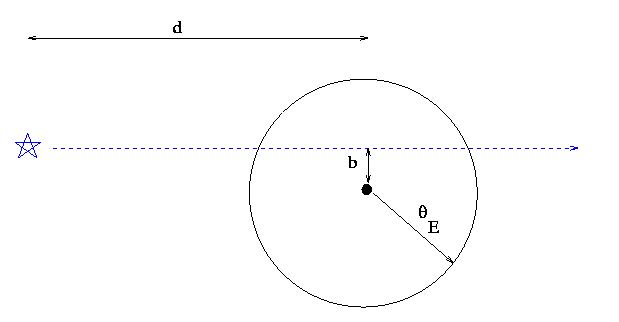
 Copyright © Michael Richmond.
This work is licensed under a Creative Commons License.
Copyright © Michael Richmond.
This work is licensed under a Creative Commons License.
Due Monday, Apr 3, at 1:00 PM.
Your job this week is to work out an example of a microlensing event in our galaxy.
You will need to use this handy fact of mathematical life: if an object of length L is seen from a very large distance D,

then its angular size measured in radians is
theta = L / D
One can also turn this around: if you know the angular size
of an object in radians and its distance,
you can figure out its size:
L = D * theta
We look towards the bulge of the Milky Way, which is about 10 kiloparcsecs away from us. Halfway there, at a distance of D = 5 kpc, there is a star identical to our Sun; it acts as a gravitational lens. Call this star the "lensing star". Beyond the lensing star, another D = 5 kpc away, is a very bright star which will act as the background source. Call this star the "background star." The background star is, today, March 29, 2000, off to one side of the lens by a distance d = 2.0 x 10^12 meters.
Looking at the situation from far above it all:

Now, the background star won't pass directly in back of the lens, but it will come close. It is moving with a speed of v = 100 km/sec relative to the lens, and at closest approach will come within b = 2.5 x 10^(-9) radians of the lens:
Looking at the lens from the Earth:

Now, for the gravitational lensing: how much brighter does the background star become? Well, if from our point of view, the angular distance between the background star and the lens is r radians, then the amplification factor due to lensing is
Let u = r/theta_E
Then
u^2 + 2
amplification = -----------------
u * sqrt[u^2 + 4]
You might use the Pythagorean theorem to calculate the angular distance r from the angular distance to the side of the lens at some time and the angular distance of closest approach, b.
Last modified by MWR, Mar 29.5, 2000
 Copyright © Michael Richmond.
This work is licensed under a Creative Commons License.
Copyright © Michael Richmond.
This work is licensed under a Creative Commons License.